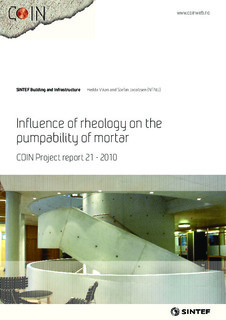| dc.description.abstract | The rheological and material parameters determining the pumpability of fresh self-compacting mortar have been studied in full-scale (70 m Ø 50 mm rubber hose and screw pump with max capacity 7 m3/h). Concrete pressure gradient over the hose length (dp/dx) and flow rate were measured to quantify pumpability. The rheological properties of the pumped mortars were measured with a ConTec BML viscometer. Finally, the rheological properties of the slip layer that occurs in vicinity of the wall of the hose during pumping was studyed as matrix phase (paste and filler < 0.125 mm) in a parallel plate rheometer.
Five different concrete mixes were investigated showing that slump flow is not suitable for differentiating pumpability. Interpretation of rheological data was, moreover, complicated since the measured values of plastic viscosity and yield stress were altered simultaneously from mix to mix.
The data imply that both yield stress and plastic viscosity govern pumpability. Increased plastic viscosity of mortar and paste was found to correlate with decreased mortar pumpability. No clear trends could be found for mortar yield stress. Increased paste yield stress was, however surprisingly, related to increased pumpability. The plastic viscosity seemed, however, to dominate yield stress when the two factors varied simultaneously within the given workability range. These parameters should, therefore, not be studied independently. Increased hysteresis area calculated from the paste measurements correlated well with reduced pump flow, also indicating a relation to the rheology of the slip layer.
The predicted pressure losses were 5-7 times higher than the measured values. This indicates that one or more of the premises of the Buckingham-Reiner equation are erroneous in these tests, like inhomogeneous fluid and slippage.
The existence of a plug is due to yield stress which was observed in both matrix and mortar. The combination of instrumented steady state pumping, concentric viscometre, parallel plate viscometer and visualized boundary flow rate were used to estimate slip layer thickness. The modified Buckingham Reiner equation resulted in slip zone thickness in the order of 0.6 – 1 mm. The thicknesses were not sensitive to variations in matrix yield stress, whereas plastic viscosity had a major effect as shown in plots of slip zone viscosity vs slip zone thickness. At the slip zone thickness corresponding to the matrix rheology, the calculated specific viscosities (Pa•s/m) were all similar to the lowest values reported by Kaplan (2001). The average rates of shear in the thinnest slip zone were estimated to be as high as 1000 [s-1]. This is much higher than those used in the parallel plate viscometer [100 s-1] and future parallel plate viscometre test made in conjunction with studies of this kind should be carried out to 1000 [s-1].
Based on a few flow profile calculations and comparison with visualized profiles it seems reasonable to assume that the rheological properties of the concrete are not constant, but vary over the cross section of the tube and possibly also along the tube due to factors such as tixotropic behaviour, possibly shear thickening, stiffening, wall effects and/or segregation under shear.
Some investigations of effect of pumping on compressive strength were made by measuring strength on cubes made from concrete before and after pumping. These showed negligible effects of pumping on strength.
Further research recommendations are given. | nb_NO |
